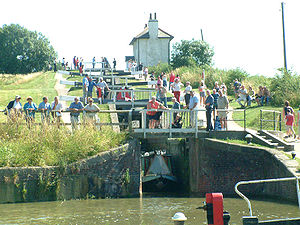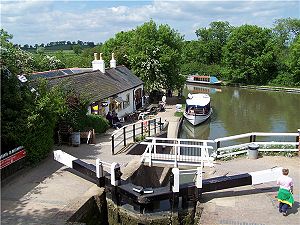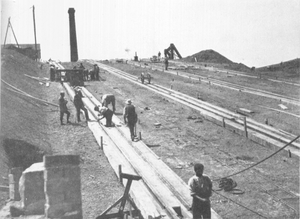
Foxton Locks
Encyclopedia


Grand Union Canal
The Grand Union Canal in England is part of the British canal system. Its main line connects London and Birmingham, stretching for 137 miles with 166 locks...
about 5 km west of the Leicestershire
Leicestershire
Leicestershire is a landlocked county in the English Midlands. It takes its name from the heavily populated City of Leicester, traditionally its administrative centre, although the City of Leicester unitary authority is today administered separately from the rest of Leicestershire...
town of Market Harborough
Market Harborough
Market Harborough is a market town within the Harborough district of Leicestershire, England.It has a population of 20,785 and is the administrative headquarters of Harborough District Council. It sits on the Northamptonshire-Leicestershire border...
and are named after the nearby village of Foxton
Foxton, Leicestershire
thumb|Foxton parish churchFoxton is a village in Leicestershire, England, to the north-west of Market Harborough. It is on the Grand Union Canal and is the site of the Foxton Locks and Foxton Inclined Plane.-External links:****...
.
They form the northern terminus of a 20-mile summit level that passes Husbands Bosworth
Husbands Bosworth
Husbands Bosworth is a large crossroads village in South Leicestershire on the A5199 road from Leicester city to Northampton and the A4304 road from Junction 20 of the M1 motorway to Market Harborough....
, Crick
Crick, Northamptonshire
Crick is a village in the Daventry district of the county of Northamptonshire in England. It is close to the border with Warwickshire, west of Rugby and north-west of Northampton. The villages of Crick and West Haddon were by-passed by the A428 main road from Rugby to Northampton when the...
and ends with the Watford flight
Watford Locks
Watford Locks is a group of seven locks on the Leicester Line of the Grand Union Canal, in Northamptonshire, England, famous for the Watford Gap service area....
Staircase locks are used where a canal
Canal
Canals are man-made channels for water. There are two types of canal:#Waterways: navigable transportation canals used for carrying ships and boats shipping goods and conveying people, further subdivided into two kinds:...
needs to climb a steep hill, and consist of a group of locks where each lock opens directly into the next, that is, where the bottom gates of one lock form the top gates of the next. Foxton Locks are the largest flight of such staircase locks on the English canal system.
The Grade II* listed locks are a popular tourist attraction
Tourist attraction
A tourist attraction is a place of interest where tourists visit, typically for its inherent or exhibited cultural value, historical significance, natural or built beauty, or amusement opportunities....
and the county council has created a country park
Country park
A country park is an area designated for people to visit and enjoy recreation in a countryside environment.-History:In the United Kingdom the term 'Country Park' has a special meaning. There are over 400 Country Parks in England alone . Most Country Parks were designated in the 1970s, under the...
at the top. At the bottom, where the junction with the arm to Market Harborough is located, there are two public houses, a shop, trip boat and other facilities. The area is popular with gongoozler
Gongoozler
A gongoozler is a person who enjoys watching activity on the canals in the United Kingdom. The term is also often used in a more general way to describe those who have an interest in canals and the canal life, but do not actively participate.-Etymology:...
s.
Alongside the locks is the site of the Foxton Inclined Plane, an inclined plane
Canal inclined plane
An inclined plane is a system used on some canals for raising boats between different water levels. Boats may be conveyed afloat, in caissons, or may be carried in cradles or slings. It can be considered as a specialised type of cable railway....
built in 1900 as a solution to various operational restrictions imposed by the lock flight. It was not a commercial success and remained in full-time operation for only ten years. It was dismantled in 1926, but a project to re-create the Plane commenced in the 2000s, since the locks remain a bottleneck for boat traffic.
The locks

In 2008, the locks became part of the European Route of Industrial Heritage
European Route of Industrial Heritage
The European Route of Industrial Heritage is a network of the most important industrial heritage sites in Europe. The aim of the project is to create interest for the common European Heritage of the Industrialisation and its remains...
, a network which seeks to recognize the most important industrial heritage
Industrial heritage
Industrial heritage is an aspect of cultural heritage dealing specifically with the buildings and artifacts of industry which are inherited from past generations, maintained in the present and bestowed for the benefit of future generations, often forming a significant attraction for tourism.The...
sites in Europe.
The locks are usually manned during the cruising season from Easter to October and padlocked outside operating hours. This is done to prevent water shortages due to misuse and to ensure a balance between those wishing to ascend and descend. There can be lengthy delays at busy times but the actual transit should take approximately 45 minutes to one hour to complete; it is made quicker by the fact that the locks are narrow beam and the gates are light.
Foxton Inclined Plane

Grand Junction Canal
The Grand Junction Canal is a canal in England from Braunston in Northamptonshire to the River Thames at Brentford, with a number of branches. The mainline was built between 1793 and 1805, to improve the route from the Midlands to London, by-passing the upper reaches of the River Thames near Oxford...
Company had acquired several of the canals comprising the Leicester line, and was keen to meet demand from carriers seeking to use wider beam (14 ft) craft, rather than the traditional narrow beam boats, which were the only type the locks could accommodate. Their solution was to build an inclined plane
Canal inclined plane
An inclined plane is a system used on some canals for raising boats between different water levels. Boats may be conveyed afloat, in caissons, or may be carried in cradles or slings. It can be considered as a specialised type of cable railway....
to the side of the locks. Initially, the company had planned for the plane to replace the locks, rather than having it act as a second, faster option. Construction began in 1898 and was finished by 10 July 1900.
The Plane was designed by Gordon Cale Thomas, after a large-scale prototype was built at the company's Bulbourne yard and he had assessed the 75 ft climb. It had two tanks, or caissons, each capable of holding two narrowboat
Narrowboat
A narrowboat or narrow boat is a boat of a distinctive design, made to fit the narrow canals of Great Britain.In the context of British Inland Waterways, "narrow boat" refers to the original working boats built in the 18th, 19th, and 20th centuries for carrying goods on the narrow canals...
s or a barge
Barge
A barge is a flat-bottomed boat, built mainly for river and canal transport of heavy goods. Some barges are not self-propelled and need to be towed by tugboats or pushed by towboats...
. The caissons were full of water, and so balanced each other. The caissons' vertical guillotine gates created a watertight seal. The lift was powered by a 25 horsepower (19 kW) stationary steam engine
Stationary steam engine
Stationary steam engines are fixed steam engines used for pumping or driving mills and factories, and for power generation. They are distinct from locomotive engines used on railways, traction engines for heavy steam haulage on roads, steam cars , agricultural engines used for ploughing or...
. The land for the Plane was purchased for £1,595 and total expenses for the project came to £39,244 by 24 June 1900.
The inclined plane had a journey time of 12 minutes for two boats up and two down, compared with 1¼ hours through the old lock system, thereby improving the speed of passage up the hill tremendously. During a 12-hour day, 6,000 tons
Long ton
Long ton is the name for the unit called the "ton" in the avoirdupois or Imperial system of measurements, as used in the United Kingdom and several other Commonwealth countries. It has been mostly replaced by the tonne, and in the United States by the short ton...
(6,100 tonnes) of cargo could pass through the upper and lower level. Unlike the locks, where water flowed downhill every time a boat passed through, on the inclined plane almost the same amount of water went up and down the hill. Only the displaced water is moved, thus saving a great deal of water and giving better control of this vital resource.
An initial problem with the plane was the stress on the tracks by the caissons. There was a plan to build a similar inclined plane
Canal inclined plane
An inclined plane is a system used on some canals for raising boats between different water levels. Boats may be conveyed afloat, in caissons, or may be carried in cradles or slings. It can be considered as a specialised type of cable railway....
at the Watford Locks
Watford Locks
Watford Locks is a group of seven locks on the Leicester Line of the Grand Union Canal, in Northamptonshire, England, famous for the Watford Gap service area....
at the southern end of the canal's summit level. However, this was never carried through (perhaps due to the low levels of traffic in the plane's first two years), and as the Watford Locks were never widened, the economic benefits of the plane could not be fully realised. The need to continually maintain a supply of steam for the plane's engine – in expectation of traffic – also proved to be a drain on finances. Thus, despite its obvious effectiveness, the Foxton Inclined Plane was mothballed in 1911 to save money. After that date it saw occasional use when the locks were undergoing maintenance.
In 1926, dismantling of the incline's machinery began, and it was sold for scrap in 1928 for a mere £250. That year the chimney on the engine house was demolished and its bricks used for various canal repairs.
The plane today
The remains of the plane can still be seen, and the site explored by visitors (to a limited extent).The mooring bollards from the incline can be found alongside the locks.
Foxton Canal Museum
The Foxton Canal Museum is located in the former boiler house for the plane's steam engine. The museumMuseum
A museum is an institution that cares for a collection of artifacts and other objects of scientific, artistic, cultural, or historical importance and makes them available for public viewing through exhibits that may be permanent or temporary. Most large museums are located in major cities...
covers the history of the locks and the plane, the lives of the canal workers, and other aspects of the local canal. There is also a collection of Measham
Measham
Measham is a village in Leicestershire, near the Staffordshire and Derbyshire border, located just off the A42 just south of Ashby-de-la-Zouch, and within the National Forest...
pottery.
The museum opened in 1989 and is accredited by the Museums, Libraries and Archives Council
Museums, Libraries and Archives Council
The Museums, Libraries and Archives Council is a non-departmental public body in England and a registered charity with a remit to promote improvement and innovation in the area of museums, libraries and archives...
.
Restoration

Scheduled Ancient Monument
In the United Kingdom, a scheduled monument is a 'nationally important' archaeological site or historic building, given protection against unauthorized change. The various pieces of legislation used for legally protecting heritage assets from damage and destruction are grouped under the term...
and was on the Monuments at Risk Register. This recognition, together with the steady increase in leisure boating on British canals, means its restoration is now considered a key project in the development of the national waterway network.
The cost of full restoration has been estimated at £9 million (2006 figures), and is to be tackled in a series of stages.
Stage 1 of the project – the clearing of the site and restoration of the canal arms above and below the plane – was completed in 2008. A grant for £1.7 million was received from the Heritage Lottery Fund
Heritage Lottery Fund
The Heritage Lottery Fund is a fund established in the United Kingdom under the National Lottery etc. Act 1993. The Fund opened for applications in 1994. It uses money raised through the National Lottery to transform and sustain the UK’s heritage...
towards the £2.8 million cost of this first stage, and its successful completion resulted in the site being removed from the Monuments at Risk register.
See also
- Bingley Five Rise LocksBingley Five Rise LocksBingley Five Rise Locks is a staircase lock on the Leeds and Liverpool Canal at Bingley . As the name implies, a boat going up the lock is lifted in five stages.-Description:...
in West Yorkshire - Bingley Three Rise LocksBingley Three Rise LocksBingley Three Rise Locks is a staircase of three locks on the Leeds and Liverpool Canal at Bingley, West Yorkshire, England. It opened in 1774 and was a major feat of engineering at the time along with the larger Five Rise opened at the same time and several hundred metres further up...
in West Yorkshire - Foxton Inclined Plane TrustFoxton Inclined Plane TrustThe Foxton Inclined Plane Trust is a waterway society and a registered charity on the Grand Union Canal at Foxton, Leicestershire, England, UK...
- Watford LocksWatford LocksWatford Locks is a group of seven locks on the Leicester Line of the Grand Union Canal, in Northamptonshire, England, famous for the Watford Gap service area....
in Northamptonshire - Caen Hill LocksCaen Hill LocksCaen Hill Locks are a flight of locks on the Kennet and Avon Canal, between Rowde and Devizes in Wiltshire England.The 29 locks have a rise of 237 feet in 2 miles or a 1 in 44 gradient. The locks come in three groups. The lower seven locks, Foxhangers Wharf Lock to Foxhangers Bridge Lock, are...
near Devizes, Wiltshire - Fourteen LocksFourteen LocksFourteen Locks is a series of locks, also known as the Cefn Flight, on the Crumlin arm of the Monmouthshire Canal at Rogerstone in Newport, South Wales. The flight of locks was completed in 1799 and raises the water level 160 ft in just 800 yd...
near Newport, South Wales - Tardebigge LocksTardebigge LocksTardebigge Locks or the Tardebigge Flight is the longest flight of locks in the UK, comprising 30 narrow locks on a two and a quarter mile stretch of the Worcester and Birmingham Canal at Tardebigge, Worcestershire...
near Bromsgrove, Worcestershire

